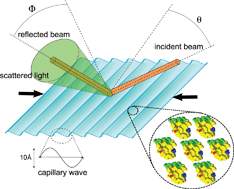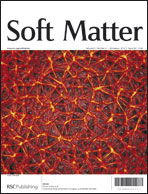We show unexpected viscoelastic response in dilute conditions for hydrophobin layers subjected to compression in a Langmuir trough. The surface pressure, surface dilatational and shear viscoelasticity, and layer thickness, are probed by combining four different experimental techniques: Wilhelmy plate tensiometry, Surface Quasi-Elastic Light Scattering (SQELS), Surface Shear Rheology and Ellipsometry. At a surface pressure around 6–15 mN m−1, the isotherm measured by a Wilhelmy plate displays erratically a kink or small plateau feature. The build up to this point has been probed with SQELS. SQELS data itself require careful interpretation because the Wilhelmy plate measurements cannot be taken as a valid independent measurement of surface pressure for solid-like films. The SQELS raw signal shows a decrease of the capillary wave frequency, while the surface pressure measured by a Wilhelmy plate is still approximately zero. This could be attributed to either an increase of the layer surface pressure not seen by the Wilhelmy plate, and/or to the presence of significant dilatational response; analysis of the SQELS signals indicates a small finite dilatational modulus in the dilute hydrophobin layer. Shear rheology measurements indicate that within this region, the layer acquires some rigidity. Ellipsometry measurements interestingly show that the layer already has a finite thickness in these dilute conditions, and that the thickness increases linearly through the compression until the layer collapses. Combining these elements allows us to develop a clear picture of the build up of surface tension and viscoelasticity within the hydrophobin layer: the layer becomes viscoelastic at pressures which are still negligible. This is consistent with previous reports in the literature of co-existence of condensed and dilute protein domains, if the domain lengthscale is smaller than the area probed by the techniques employed here.

You have access to this article
 Please wait while we load your content...
Something went wrong. Try again?
Please wait while we load your content...
Something went wrong. Try again?


 Please wait while we load your content...
Please wait while we load your content...